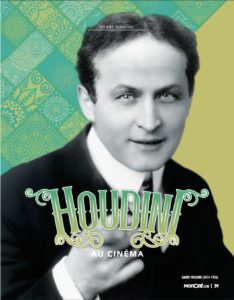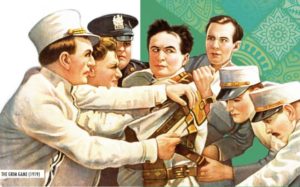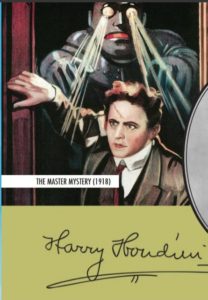Thanks to the mighty Arthur Moses, the French Canadian magazine, Monciné, with a Houdini article and artwork from his movies arrived in the mail this week.
For your reading pleasure, I took the liberty to translate the article from French to English via google translate:
It seems that Houdini’s name is known to a very large majority of people in the world. Deceased in 1926, long before the internet and television and even before talking cinema, Houdini still fascinates as much.
He is considered one of the greatest magicians of all time. How could his legend cross the last century despite the presence of great magic like David Copperfield? Why does Houdini’s name remain etched in people’s memories as an exceptional artist who transcends time?
Harry Houdini, whose real name is Ehrich Weisz, was born on March 24, 1874 in Budapest, Austria-Hungary. He immigrated to the United States with his parents in 1878 at the age of four and died on October 31, 1926, in Detroit, United States. He took the name Harry Houdini because of his admiration for the Frenchman Jean-Eugene Robert-Houdin, the father of modern magic.
He becomes famous thanks to his escape numbers and his publicity shots allowing him to attract the public to his shows. His two favorite numbers were to lock himself in a completely padlocked case submerged in a river, or to be tied by the feet at the top of a building and to try to free himself from a straitjacket. He also has the ability to free himself from all types of handcuffs. Among other things, he managed the feat of escaping from a safe and even from a London prison. In short, Houdini has everything of the superhero of his time, in addition to mastering the art of marketing.
An artist committed against fake mediums, during the height of spiritism, he went around the world to find concrete evidence of communication with the afterlife. This battle is motivated by the death of his father with whom he hoped so much to communicate with again. This search for fake mediums and the truth about the afterlife angered a long intellectual battle between him and Arthur Conan-Doyle (creator of Sherlock Holmes), who strongly believed in spiritualism. On the other hand, the latter did not know, like Houdini, all the fraudulent means that could exist to make ghosts believe.
Houdini has published many books during his career and participates as a main actor in some films. In most of his cinematographic exploits, he tried to free himself from handcuffs, straitjackets or crates surrounded by chains with his escape techniques. Of course, he managed to free himself and catch the bad guys.
As an actor, his most notable films are:
The Master Mystery (1918)
The Grim Game (1919), Terror Island (1920)
After three films, Houdini created his own production company. He invested $500,000 with his friends in this new company. Over the next two years, he starred in two other films he directed himself.
The Soul of Bronze (1921), Haldane of the Secret Service (1923)
In 1923, he closed the company, complaining of insufficient profits. His tours of shows around the world were much more profitable. Ironically, when Houdini got his star on the Hollywood Walk of Fame, it was for his work in film rather than for his success on stage.
Despite his great popularity and the richness of his personna, few films have been made about him. Among the most important are the 1976 telefilm The Great Houdini, played by Paul Michael Glaser and directed by Melville Shavelson. In 2014, Adrien Brody played the famous magician in the two-part Canadian historical mini-series Houdini, The Illusionist. Finally, the most important is Houdini the great magician (Houdini, original title) directed by George Marshall and based on the scenario of Philip Yordan, after the work of Harold Kellock. This film, starring Tony Curtis and Janet Leigh, was released on July 2, 1953. It tells the different aspects of Houdini’s life in a very romanticized and somewhat distorted way, not to say totally different from reality. It is certain that this film has added even more mystery around the legend and the character.
Houdini’s name is often mentioned in movies or TV series when it comes time to talk about spiritism or a place in an impossible way.
It should be noted that Houdini and his wife Wilhelmina Beatrice Rahner agreed on a secret code in order to communicate from the afterlife, if one or the other died. This code was never revealed. And Beatrice never received messages from Houdini in her lifetime.
During his career, Houdini created numbers that are still presented by magicians today, like Water Torture Cell. More than 100 years after their creation, they still keep their appeal to the public. In addition, they remain as mysterious as ever.
Houdini is an extraordinary character. Nearly a century after his death. The magician continues to intrigue and the mystery around him continues to grow.





Oh, very nice. But they clearly make a big mistake listing The Soul of Bronze instead of The Man From Beyond.
Big mistake indeed!